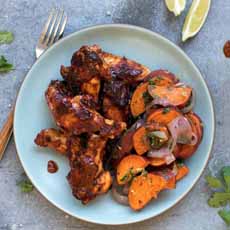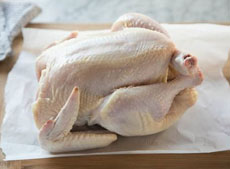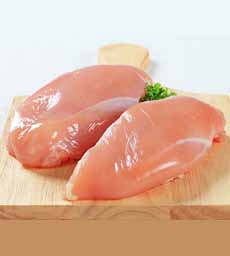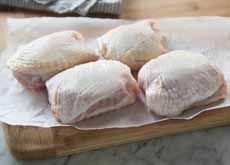|
You may be putting chicken on the grill this weekend.
For advice, we spoke with Claudia Sidoti, Head Chef and Head Recipe Developer at HelloFresh, a popular meal ingredients delivery service that makes it easier to cook delicious, nutritious meals (a gift for Father’s Day?).
Claudia reminds us that dark meat chicken is “so much better on the grill than white meat. It stays moist and the skin gets nice and crispy.”
To save money but still keep guests happy, she recommends BBQ chicken wings and drumsticks.
“They key to perfecting dark meat,” she says, “is a good marinade and setting up the grill for direct and indirect heat, so you can get the meat cooked through without burning the skin.”
For cooking indoors, here are Claudia’s chicken-cooking tips.
HOW TO COOK A WHOLE CHICKEN
Pat dry. Dry = crispy. Start with a 4-5 pound broiling or frying chicken. Dry the chicken well with paper towels, inside and out. For best results, open the package in the morning or even the night before, and leave it, uncovered, on a rack in a roasting pan in the fridge.
Flavor the cavity. To add some extra moisture and flavor, cut a lemon, onion, or even an apple in chunks and place them in the cavity, along with a sprig or two of fresh herbs or bay leaves. As the chicken roasts, these aromatics will release moisture and flavor. Just remember to remove them before carving.
Truss and tuck. Truss (tie) the legs and tuck in the wings. Not only does this make for a prettier presentation, but it also helps keep the breasts from drying out while cooking.
Should you baste? There are some people who love to dot their chicken with butter or brush it with oil before cooking, then baste while it’s roasting. However, if you like crispy skin crispy, both of these reduce the crispiness factor. Also, every time you open the oven, the temperature drops, so it’s best to keep the chicken at an even temperature and let the oven do the work.
Slow and steady. Roast the chicken at 350°F all the way. On average, you’ll want to cook the chicken about 15 -20 minutes per pound. This keeps the white meat moist and ensures that the dark meat is cooked through.
HOW TO COOK A CHICKEN BREASTS
Smaller is better. Breasts of 6-7 ounces apiece is best for even cooking. If you have extra large breasts (between 8-12 ounces), cut them in half horizontally for more even cooking; pound them out for cutlets; or slice and dice them into small chunks for stir-fries.
Pat dry. By now, you know that the best-results tip starts with patting the chicken dry, inside and out. Then, season well with salt and pepper.
Shake off the marinade. If you’ve marinated the chicken, shake it off so that the chicken is as dry as possible. Most marinades have salt, so you can skip salting if you’re starting with marinated chicken breast.
Don’t overcrowd the pan. Use a wide frying/sauté pan that helps keep the splattering* to a minimum (a nonstick pan is not essential). If you crowd the pan, the breasts won’t brown as nicely and leave enough room for turning. Also consider if you’re going to be adding other ingredients like veggies or pasta.
|
|

[1] Dark meat chicken is better for grilling. You’ll have much moister chicken (photo courtesy Sun Basket).

[2] Ready, set, roast. All photos courtesy Good Eggs.

[3] While your eye may be drawn to the largest cuts, smaller breasts cook more evenly.

[4] Patting the chicken dry with paper towels limits the spatter.
|






